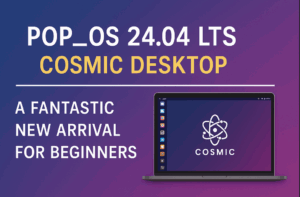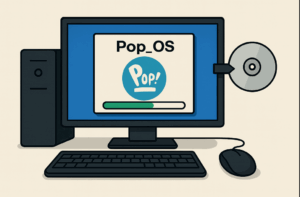Pop!_OS 24.04 with the new COSMIC desktop: the friendliest Linux for beginners (and a fantastic 2025 release)
 The brand‑new COSMIC desktop (written in Rust) brings a modern look, simple controls, and optional automatic tiling of windows to Pop!_OS. Below you’ll find why this is fantastic news for beginners and how to try it safely.
The brand‑new COSMIC desktop (written in Rust) brings a modern look, simple controls, and optional automatic tiling of windows to Pop!_OS. Below you’ll find why this is fantastic news for beginners and how to try it safely.
What is COSMIC and why should you care?
- Simple and clear interface – top panel, app launcher, and clean menus. Understandable from the first boot.
- Optional automatic window tiling – windows can arrange themselves side by side. Perfect for small and ultra‑wide monitors. Don’t want tiling? Use classic floating windows.
- Built‑in App Store – easy installation of apps, system updates, and drivers with a few clicks.
- Themes and custom colors – light/dark modes and personal color schemes. Text automatically adapts for readability.
- Performance and security – developed in Rust, focused on stability and speed.
Why it’s perfect for beginners
- Easy transition from Windows – panel, menus, and settings feel familiar; includes App Library and quick launcher.
- Less configuring, more using – automatic window tiling and sane defaults save time.
- Strong community and documentation – Pop!_OS has active support and clear guides.
- Wide hardware support – ISO images available even for NVIDIA laptops (stable 22.04 LTS). Version 24.04 with COSMIC is still testing.
https://system76.com/cosmic/
How to safely try COSMIC (without touching your disk)
- Download the ISO – official Pop!_OS 22.04 LTS (stable) + test ISO for 24.04 with COSMIC from System76’s blog.
- Create a Live USB – use balenaEtcher or Raspberry Pi Imager. Select ISO → USB drive → Flash.
- Boot Live mode – in BIOS/UEFI choose boot from USB (keys F12/F10/ESC). Select Try Demo (Live) – system runs from USB, no installation.
- Alternatively: use virtualization – run with GNOME Boxes or VirtualBox (allocate 4–8 GB RAM, enable 3D acceleration).
Tip: If you’re a complete beginner, first try Pop!_OS from a Live USB before considering installation. We can prepare a detailed illustrated guide if you’d like.
Installing Pop!_OS 24.04 LTS with COSMIC Desktop – Complete Guide
Pop!_OS is a Linux distribution developed by System76, based on Ubuntu LTS. Version 24.04 introduces the new COSMIC desktop environment, designed to be modern and user-friendly – perfect even for complete beginners.
This guide will walk you step by step through the installation process, including setting up a dual-boot system with Windows 11.
1. Preparation before Installation
1. Backup Data
- Back up all important files from Windows to an external drive or cloud.
2. Download Pop!_OS 24.04 LTS
- Official website: https://pop.system76.com
- Download the ISO file for version 24.04 LTS.
3. Create a Bootable USB
- Use Rufus (Windows) or balenaEtcher (Linux/Mac).
- Select the ISO file and create a USB stick (at least 8 GB).
4. BIOS/UEFI Settings
- Enter BIOS (usually F2, Del, or Esc during startup).
- Ensure UEFI mode is enabled.
- Disable Secure Boot if necessary.
2. Disk Partitioning for Dual Boot with Windows 11
If you want to use Windows 11 and Pop!_OS on the same disk, you need to partition it correctly.
| Partition | Size | File System | Purpose |
| EFI (already exists) | 100–500 MB | FAT32 / VFAT | Shared boot partition (Windows and Linux) |
| Windows C: | as needed | NTFS | Main partition for Windows 11 |
| Free space | min. 40 GB | - | Prepared for Pop!_OS |
| / (root) | 25–50 GB | ext4 | System partition for Pop!_OS |
| /home | remaining space | ext4 | User data (documents, settings) |
| swap (optional) | 2–4 GB (or =RAM) | swap | Swap space, hibernation |
Note on the EFI partition:
In the installer, the file system for this partition may appear as FAT32 or VFAT. Both are identical – Linux uses the term vfat for the FAT32 driver. So it may look different than in Windows, but it works the same.
Important: Do not create or format the EFI partition again. Use the existing one from the Windows installation and simply mark it as “EFI System Partition”.
3. Installing Pop!_OS
1. Boot from USB
- Restart your PC and boot from USB.
2. Select “Try or Install Pop!_OS”
- Starts the COSMIC live environment.
3. Launch the installer
- Click the “Install Pop!_OS” icon.
4. Choose language and keyboard
- Select English or another preferred language.
5. Installation type
- Choose “Custom (Advanced)” – required for dual boot.
6. Partitioning
- Use the free space you created in Windows.
- Create root (/), home (/home), and optionally swap.
- Assign the existing FAT32/VFAT partition as the EFI System Partition.
7. Start the installation and wait for it to complete.
4. Finishing Installation
1. Restart – after installation, restart your PC. A menu will appear with the option to boot Pop!_OS or Windows.
2. First boot – set up username, password, timezone, and internet connection.
5. Recommended First Steps after Installation
- Run updates:
sudo apt update && sudo apt upgrade -y
- Check graphics drivers (NVIDIA/AMD).
- Set boot order in BIOS if you want Pop!_OS or Windows to start by default.
✅ Done! You now have a working dual-boot setup with Pop!_OS 24.04 LTS (COSMIC Desktop) and Windows 11.
Lenovo ThinkPad P14s Gen 6 AMD
– mobile workstation with official Ubuntu certification
Configuration: AMD Ryzen AI 7 PRO 350, 32 GB DDR5 RAM, 1 TB NVMe SSD, integrated Radeon 880M graphics, 14″ WUXGA display (1920×1200, 400 nits, anti-glare), Wi-Fi 6E / BT 5.4
approx. £1,800 (reference price)Show detailsHide details
- Ubuntu 24.04 LTS certified: Lenovo and Canonical verified full hardware support (CPU, GPU, Wi-Fi, suspend/resume, firmware updates via LVFS).
- Display: 14″ IPS WUXGA (16:10) with 400 nits brightness and anti-glare finish, comfortable for indoor and outdoor work.
- Performance: 8-core Ryzen AI PRO 350 with Radeon 880M iGPU handles multitasking, development workloads, and Linux graphics acceleration smoothly.
- Security and manageability: AMD PRO features, TPM 2.0 chip, and enterprise-grade ThinkPad security.
Why it is “Linux-ready”
- Official certification: guaranteed support on Ubuntu 24.04 LTS and upcoming releases.
- Battery life: up to 12 hours depending on configuration and power mode.
- Developer-friendly: seamless Wayland support, multi-monitor setup, and open-source Radeon drivers.
Recommendations
- Install Ubuntu 24.04 LTS (OEM/HWE kernel) or Fedora 41+ for the latest drivers.
- After installation run
fwupdmgr updateand updatelinux-firmwarepackages. - Use
tlporpowertopto optimize battery life for daily use.
Affiliate links (Amazon/eBay/Smarty.cz via eHub). Buying through them supports this site’s operation and functionality at no extra cost to you.
Easy VPN for Linux – no complicated setup
If you don’t want to create your own VPN or you’re struggling to configure everything on Linux, here’s a simple solution. Try a ready-to-use VPN for Linux with a clean graphical interface – fast, secure, and hassle-free.
View deals on Amazon →Tip: Quick installation, user-friendly GUI, no unnecessary complexity.
Affiliate links (Amazon/eBay/Smarty.cz via eHub). Buying through them supports this site’s operation and functionality at no extra cost to you.

